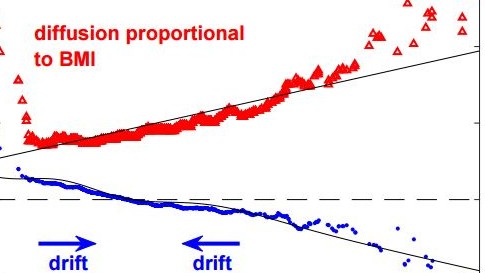Data Mining Is Revolutionizing Our Understanding of Human Weight Change
Obesity is one of the scourges of the modern world. The reasons for our expanding waistlines are many—chief among them are easy access to high-energy-density food and our increasingly sedentary lifestyles.
Other factors are also thought to play a role, such as genetic predisposition, gut flora and fauna, and peer pressure. There is also the runaway-train theory that larger people are subject to a vicious self-reinforcing cycle of weight gain.
It’s easy to get the impression that in the developed world people are on an inescapable, slippery slope of weight gain. But how true is this?

Today we get an answer thanks to the work of John Lang at the University of Waterloo in Canada and a couple of pals. They've crunched through the anonymized medical records of 750,000 patients in the Chicago area from 1997 to 2014. And their findings are something of a surprise.
The data looks at body mass index, defined as mass divided by height squared and a standard measure of relative body weight. Individuals with a BMI of less than 18.5 are underweight, a normal weight is 18.5 to 25, overweight is 25 to 30, and anyone with a BMI higher than 30 is obese.
In high-income societies, the distribution of BMI is skewed toward being overweight and obese. Previous studies have shown that this is not result of demographic or socioeconomic factors, since the same effect is observed in all social and demographic subgroups. So what else could be going on?
Lang and co have found some counterintuitive patterns. For example, the data does not back up the idea that everyone is on the same slippery slope. On overage, the population’s BMI increases over time and underweight people certainly tend to increase their BMI. But the overweight and obese tend to reduce their BMI over time. “On short timescales of about a year, the BMIs of individuals in a human population show a natural drift on average toward the center of the BMI distribution,” says Lang and co.
And there is another important effect at work. There are also random fluctuations in weight, and crucially, these turn out to be proportional to the BMI itself. So the weight of heavier people varies over a greater range than the weight of lighter people.
These findings point to a new explanation for why the BMI distribution is skewed toward higher values. Any natural variation in weight has a bigger impact on heavier people than on lighter ones, and this causes a kind of diffusion of the BMI distribution. “[People] are subject to large-amplitude fluctuations (with both positive and negative signs) that broaden the BMI distribution more on the high-BMI side than the low-BMI side,” say Lang and co. That’s why the distribution is skewed toward higher BMIs.
This work also points to a new way of modeling human weight change. “Our results establish a form of statistical mechanics for human weight change,” say the team.
Lang and co show that the data can be modeled using exactly the same statistical mechanics that explains other drift-diffusion processes, which are common in physics and finance. For example, physicists use a drift-diffusion model to explain Brownian motion.
“Our empirical findings and model provide a new fundamental understanding of the role of drift and diffusion mechanisms in the dynamics of BMI distributions in human populations,” conclude Lang and co.
That has significant implications. For a start, it pours cold water on the runaway train theory of weight gain. “There is, at first instance, no need to invoke singular effects such as the ‘runaway train’ mechanism, in which high-BMI individuals become subject to a self-reinforcing cycle of weight gain,” they say.
And it also has implications for public health policy. It helps justify interventions that target the whole population, for example. And it suggests that public policy should be to prevent big fluctuations in weight change. “Our results confirm that reducing these fluctuations by discouraging perturbations such as yo-yo dieting should be another focus of intervention,” say Lang and co.
You have been told!
Ref: arxiv.org/abs/1610.00656: The Statistical Mechanics of Human Weight Change
Keep Reading
Most Popular
Large language models can do jaw-dropping things. But nobody knows exactly why.
And that's a problem. Figuring it out is one of the biggest scientific puzzles of our time and a crucial step towards controlling more powerful future models.
The problem with plug-in hybrids? Their drivers.
Plug-in hybrids are often sold as a transition to EVs, but new data from Europe shows we’re still underestimating the emissions they produce.
How scientists traced a mysterious covid case back to six toilets
When wastewater surveillance turns into a hunt for a single infected individual, the ethics get tricky.
Google DeepMind’s new generative model makes Super Mario–like games from scratch
Genie learns how to control games by watching hours and hours of video. It could help train next-gen robots too.
Stay connected
Get the latest updates from
MIT Technology Review
Discover special offers, top stories, upcoming events, and more.